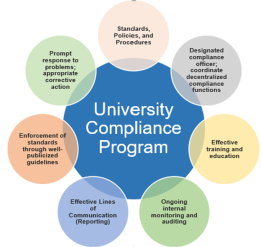Seven Elements of Effective Compliance
Chapter 8 of the Federal Sentencing Guidelines (the “Guidelines”) provides guidance and direction for establishing and maintaining an effective ethics and compliance program. The Guidelines identify seven essential elements for effective ethics and compliance programs. The compliance profession, through organizations such as the Higher Education Compliance Alliance ("HECA") has refined those elements to better define how they work in practice. Ohio University adopts the following approaches to these elements:
1. Maintaining current standards of conduct, policies, and procedures
The university will establish clear guidance to facilitate compliance with relevant federal, state, local, and international law. This includes development and updating of policies and procedures that meet the requirements of law that regulates Ohio University in all its operations. Policies will be kept up to date.
2. Designating a compliance office
A critical element of compliance is establishing clear oversight and accountability at the management and operational levels.The Office of Audit, Risk, and Compliance does not assume the duties of the various substantive compliance areas and compliance activities continue in their current reporting structures. However, Ohio University established a university-wide compliance oversight function with the reorganization and launch of the Office of Audit, Risk, and Compliance (July 2022)
If you have questions about compliance at Ohio University, you may contact the office or individual responsible for the compliance function. If you are unsure who to contact or have concerns about compliance efforts, you may contact:
Laura L. Myers, J.D., M.A., Director of University Compliance, Office of Audit, Risk, and Compliance
3. Conducting effective training and education
OARC seeks to leverage current training programs to meet federal and state obligations and collaborate with other stakeholders to develop new or enhanced training as needed.
4. Developing effective lines of communication
OARCH encourages increased outreach through training about compliance processes to ensure employees are aware of their compliance obligations and how to complete them. If compliance is not met, members of the university community are encouraged to raise concerns and ask questions, up to and including reporting non-compliance to a supervisor or unit, the Office of Audit, Risk, and Compliance, or through the confidential EthicsPoint Hotline.
5. Conducting ongoing internal monitoring and auditing
OARC supports compliance efforts through consultation and collaborative problem-solving. Additional methods and tools may include
- Audits
- Current state analysis and process mapping
- Compliance testing
- Peer Reviews
- External Audits, Reviews and Inspections
6. Enforcing standards through well-publicized guidelines
Consequences for non-compliance will be levied consistently regardless of the employee’s stature within the organization.
Enforcement must be transparent and consistent with appropriate disciplinary action through relevant authority:
- HR’s progressive discipline guidance and procedures
- Faculty Handbook
- Student Code of Conduct
- Office or departmental protocols
7. Responding promptly to detected problems and undertaking corrective action
Ohio University will have systems in place to evaluate compliance and seek ongoing program improvements
- Central and decentralized compliance programs must evolve as the risks confronting the organization change
